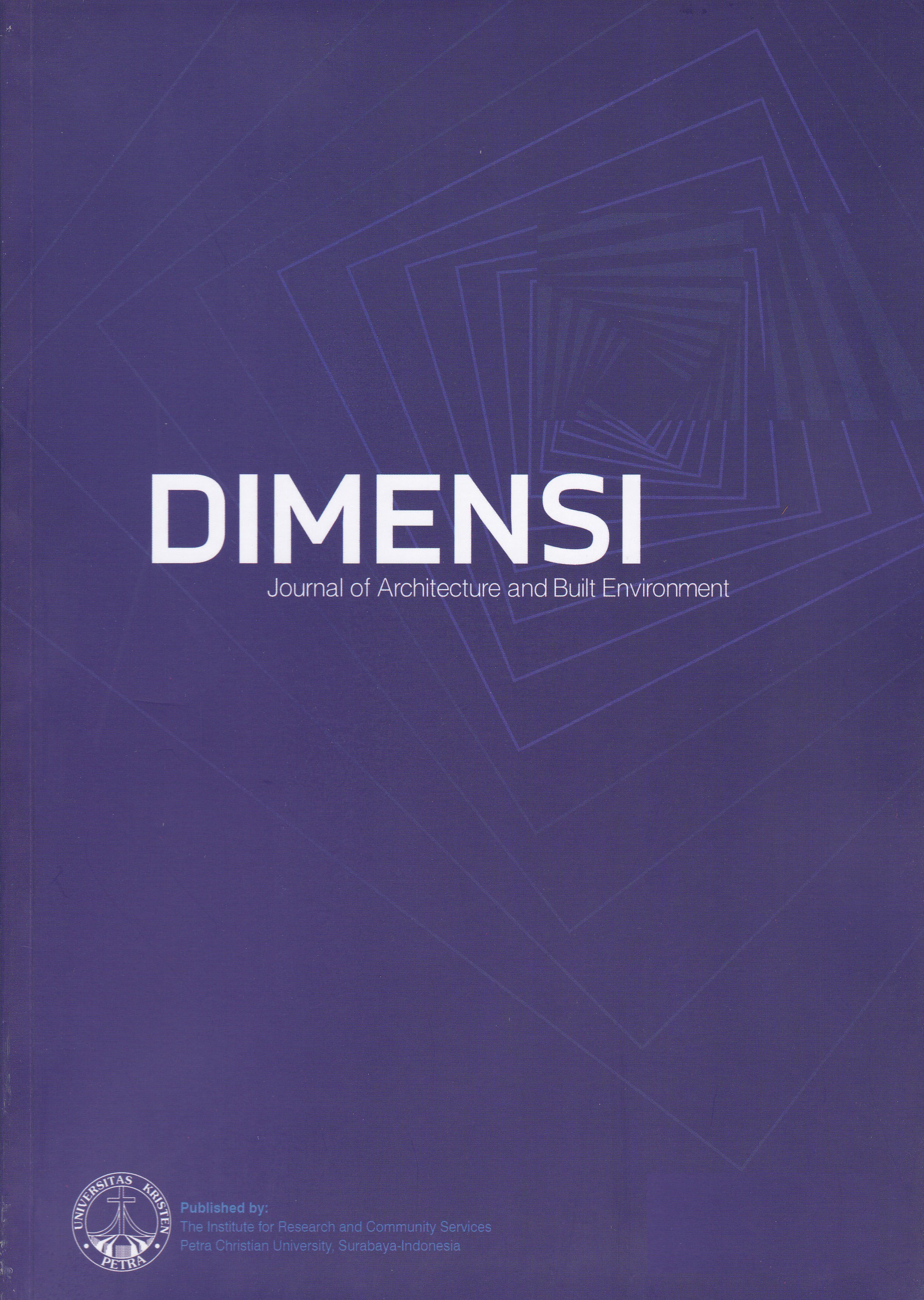LIGHTWEIGHT AND MULTI-PURPOSE PARTITION FOR VERTICAL HOUSING
DOI:
https://doi.org/10.9744/dimensi.48.2.149-156Keywords:
Adaptable space, do it yourself, lightweight material, modular construction, transformable partitionAbstract
Vertical housings have been developed to solve housing quality degradation due to rapid urbanization. These housings are often lack of privacy and comfort, since the lay-out mostly consists of one open plan space with limited area. This paper presents a lightweight and multi-purpose partition to improve the living quality in vertical housings. The lightweight characteristic is intended to minimize structural loads, while the multi-purpose property allows the partition to be transformed into some furniture for spatial efficiency. A literature review and material surveys were performed prior to material selection and the design process. Then, physical model experiments were carried out to simulate the installation process and the transformation process of the partition modules into some furniture. Result show that the partition’s weight is only 11-36.7% of the common partition wall, and when installed, the transformable property enables an adaptable space which can be adjusted to the occupants’ different conditions.
Downloads
References
Adisurya, S.I. 2016. Kajian besaran ruang pada unit rumah susun di Jakarta. [Study of area adequacy at vertical housing units in Jakarta]. Dimensi 1(1): 93-112 [in Bahasa Indonesia]. https://www.trijurnal.lemlit.trisakti.ac.id/dimensi/article/view/1781/1541
Al-Kodmany, K. 2018. The sustainability of tall build-ing developments: A conceptual framework. Buildings, 8(7). DOI:10.3390/buildings8010007.
Bremner, T.W. 2008. Lightweight concrete. In Mindess, S. (ed.). Developments in the formulation and reinforcement of concrete. Woodhead Publishing, Cambridge. DOI: 10.1533/97818456 94685.167
Ferdous, W., Bai, Y., Ngo, T.D., Manalo, A. & Mendis, P. 2019. New advancements, challenges and opportunities of multi-storey modular buildings – A state-of-the-art review. Engineering Structures, 183, 883-893. DOI:10.1016/j.engstruct.2019.01. 061.
Generalova, E.M., Generalov, V.P. & Kuznetsova, A.A. 2016. Modular buildings in modern con-struction. Procedia Engineering 153: 167-172. DOI: 10.1016/j.proeng.2016.08.098
Hays, J. & Mason, B. 2018. 8 transforming furniture solutions for small space living. The Spruce, 17 September. Accessed July 2019 from https://www. thespruce.com/transforming-furniture-for-small-spaces-4058276
Himasree, P.R., Ganesan, N. & Indira, P.V. 2017. Bamboo as a substitute for steel in reinforced concrete wall panels. IOP Conference Series: Earth and Environmental Science, 80 (012041): 1-8. DOI:10.1088/1755-1315/80/1/012041
Husain, S.F. & Shariq, M. 2018. Low cost modular housing - A review. International Conference on Advances in Construction Materials and Struc-tures. IIT Roorkee, Roorkee, India. https://www. researchgate.net/publication/323099699_Low_Cost_Modular_Housing-A_Review
Jin, R., Gao, S., Cheshmehzangi, A. & Aboagye-Nimo, E. 2018. A holistic review of off-site construction literature published between 2008 and 2018. Journal of Cleaner Production, 202, 1202-1219. DOI:10.1016/j.jclepro.2018.08.195.
Julistiono, E.K. 2011. Sustainable incremental house with modular construction. Proceedings of International Conference "Local Wisdom in Global Era". Duta Wacana Christian University, Yogyakarta, Indonesia. http://fportfolio.petra.ac.id/ user_files/04-001/Paper%20CIB%20Eunike.pdf
Mateus, R., Neiva, S., Braganca, L., Mendonca, P. & Macieira, M. 2013. Sustainability assessment of an innovative lightweight building technology for partition wall - Comparison with conventional technologies. Building and Environment 67: 147-159. DOI:10.1016/j.buildenv.2013.05.012
Novais, R.M., Senff, L., Carvalheiras, J., Seabra, M.P., Pullar, R.C., & Labrincha J.A. 2019. Sustainable and efficient cork inorganic polymer composites: An innovative and ecofriendly approach to produce ultra-lightweight and low thermal conductivity materials. Cement and Concrete Composites 97: 107-117. DOI: 10.1016/ j.cemconcomp.2018.12.024.
Putra, Y.M.P. 2016. Pemkot Surabaya tambah 18 titik rusun [Surabaya Government adds 18 new vertical housings]. Republika, 6 April [in Bahasa Indonesia]. Accessed May 2019 from https://www. republika.co.id/berita/nasional/daerah/16/04/06/o57 sxg284-pemkot-surabaya-tambah-18-titik-rusun
Rogers, S.A. 2016. Small space shape shifters: 13 Transforming furniture designs. Web Urbanist, 25 May. Accessed July 2019 from https://webur-banist.com/2016/05/25/small-space-shape-shif-ters-13-transforming-furniture-designs/
Simorangkir, E. 2018. Pemerintah cuma bisa bangun 52.000 rusun hingga 2019. [Government can only build 52,000 vertical housing units up to 2019]. Detikfinance, 13 September [in Bahasa Indonesia]. Accessed May 2019 from https://finance.detik.com/properti/d-4210558/pemerintah- cuma-bisa-bangun-52000-rusun-hingga-2019.
Tambun, L.T. 2019. Tahun ini, DKI bangun tujuh rusun baru senilai Rp 709 M. [This year, Jakarta will build 7 new vertical housings worth 709 bil-lions]. Berita Satu, 18 January [in Bahasa Indonesia]. Accessed May 2019 from https://www.beritasatu. com/megapolitan/ 533300/tahun-ini-dki-bangun-tujuh-rusun-baru-senilai-rp-709-m.
Wang, L. 2017. Amazing building made from 1.5 million plastic bottles withstands fires and earthquakes. Inhabitat, 15 May. Accessed May 2019 from https://inhabitat.com/amazing-plastic-bottle-architecture-withstands-earthquakes-in-taipei/
Widayanto, E., Krisnamurti & Aswatama, K. 2011. Pengembangan model dinding pracetak dari limbah jerami sebagai pengganti bata pada rumah di wilayah rawan gempa. [Development of precast wall model made from straw waste, as replacement of bricks, for houses at earthquake prone area]. Rekayasa 8(1): 13-24 [in Bahasa Indonesia]. https://www.researchgate.net/publi-cation/316547879_PENGEMBANGAN_MODEL_DINDING_PRACETAK_DARI_LIMBAH_JERAMI_SEBAGAI_PENGGANTI_BATA_PADA_RUMAH_DI_WILAYAH_RAWAN_GEMPA
Downloads
Published
How to Cite
Issue
Section
License
Authors who publish with this journal agree to the following terms:
- Authors retain copyright and grant the journal right of first publication with the work simultaneously licensed under a Creative Commons Attribution License that allows others to share the work with an acknowledgement of the work's authorship and initial publication in this journal.
- Authors are able to enter into separate, additional contractual arrangements for the non-exclusive distribution of the journal's published version of the work (e.g., post it to an institutional repository or publish it in a book), with an acknowledgement of its initial publication in this journal.
- Authors are permitted and encouraged to post their work online (e.g., in institutional repositories or on their website) prior to and during the submission process, as it can lead to productive exchanges, as well as earlier and greater citation of published work (See The Effect of Open Access).



















